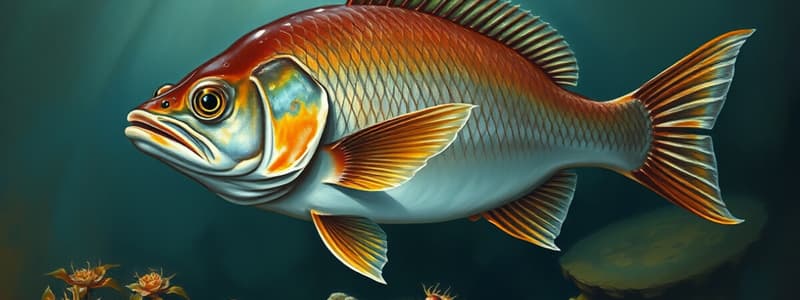Podcast
Questions and Answers
Which of the following are characteristics of fish? (Select all that apply)
Which of the following are characteristics of fish? (Select all that apply)
- They are covered with scales (correct)
- They are ectothermic (correct)
- They have two sets of paired fins (correct)
- They are warm-blooded
What are gills?
What are gills?
Extensions of the body containing thin-walled blood vessels that allow for easy absorption of oxygen.
What are gill filaments used for?
What are gill filaments used for?
Respiration
What is aquaculture?
What is aquaculture?
What purpose do scales serve in fish?
What purpose do scales serve in fish?
What is a fusiform body?
What is a fusiform body?
What is the function of the swim bladder?
What is the function of the swim bladder?
What is the operculum?
What is the operculum?
What does the lateral line system do?
What does the lateral line system do?
What is the dorsal fin's role?
What is the dorsal fin's role?
What is the caudal fin?
What is the caudal fin?
What is the anal fin used for?
What is the anal fin used for?
Which fins help in stabilizing during swimming?
Which fins help in stabilizing during swimming?
What do pectoral fins assist with?
What do pectoral fins assist with?
What is an agnathan?
What is an agnathan?
What are photophores?
What are photophores?
What is a homocercal tail?
What is a homocercal tail?
What is a heterocercal tail?
What is a heterocercal tail?
What is a diphycercal tail?
What is a diphycercal tail?
What are placoid scales?
What are placoid scales?
What defines ganoid scales?
What defines ganoid scales?
What are cycloid scales?
What are cycloid scales?
What are ctenoid scales?
What are ctenoid scales?
What are ectotherms?
What are ectotherms?
What does oviparous mean?
What does oviparous mean?
What does ovoviviparous mean?
What does ovoviviparous mean?
What is spawning?
What is spawning?
What is mouth brooding?
What is mouth brooding?
What is metamorphosis?
What is metamorphosis?
What is a hagfish?
What is a hagfish?
Flashcards are hidden until you start studying
Study Notes
Fish Characteristics
- Ectothermic creatures rely on environmental temperatures to regulate body heat.
- Covered in scales that protect against predators and parasites; reduce water friction.
- Possess paired fins (two sets) and unpaired fins for efficient swimming.
- Streamlined body shape facilitates rapid movement through water.
Respiratory Structures
- Gills consist of thin-walled blood vessels that absorb oxygen from water.
- Gill filaments are fingerlike projections facilitating gas exchange during respiration.
Reproductive Methods
- Oviparous fish lay eggs that hatch outside the body.
- Ovoviviparous fish develop eggs internally, giving birth to live young.
- Spawning refers to external fertilization of a large number of eggs.
Specialized Structures
- Swim bladder functions as a gas-filled organ, allowing fish to control buoyancy.
- Operculum is a protective flap covering the gills, keeping them safe from harm.
- Lateral line system detects water vibrations and currents, enhancing navigation.
Fins and Body Parts
- Dorsal fin assists in maintaining balance while swimming.
- Caudal fin, or tail, propels fish and aids in direction change.
- Anal fin stabilizes fish, ensuring upright movement in water.
- Pelvic fins stabilize during swimming, located towards the tail end.
- Pectoral fins control directional movement, positioned behind the head.
Types of Fins and Tails
- Fusiform bodies reduce water resistance, enhancing swimming efficiency.
- Homocercal tail features symmetrical lobes, common in most teleost fish.
- Heterocercal tail has a larger upper lobe, seen in sharks.
- Diphycercal tail tapers to a point, characteristic of lungfishes.
Scale Types
- Placoid scales are found in cartilaginous fish, resembling teeth with a sandpaper-like texture.
- Ganoid scales are large, diamond-shaped, and do not overlap; typical in gars.
- Cycloid scales are thin, overlapping, and smooth-edged, seen in primitive bony fish.
- Ctenoid scales are similar to cycloid but have tiny spines for added texture.
Other Fish Characteristics
- Hagfish represent very primitive jawless fish, retaining their notochord throughout life.
- Photophores are specialized cells in some fish that enable bioluminescence.
- Ectotherms are organisms that rely on environmental heat for warmth.
Metamorphosis
- Refers to the transformation process where larvae develop into adult forms in aquatic organisms.
Protective Strategies
- Mouth brooding involves keeping eggs or larvae in the mouth for safety.
Studying That Suits You
Use AI to generate personalized quizzes and flashcards to suit your learning preferences.




